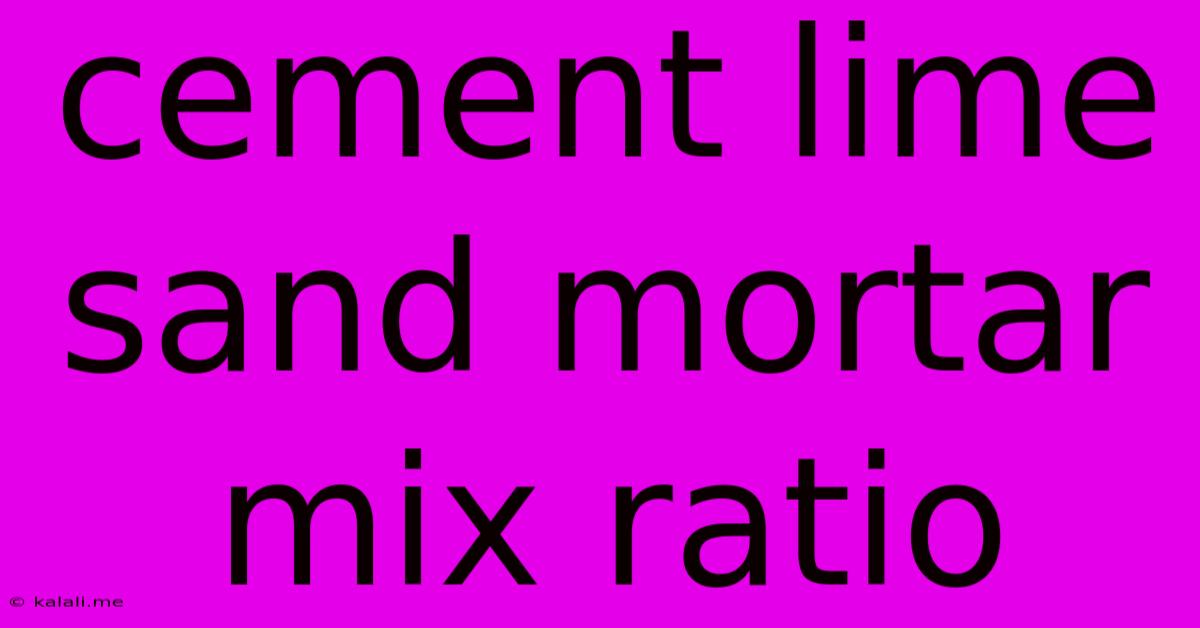Cement Lime Sand Mortar Mix Ratio
Kalali
May 22, 2025 · 3 min read

Table of Contents
Achieving the Perfect Mix: A Guide to Cement Lime Sand Mortar Ratios
Understanding the ideal cement lime sand mortar mix ratio is crucial for achieving the desired strength, workability, and durability in your masonry projects. Whether you're a seasoned builder or a DIY enthusiast, this guide will demystify the process and help you achieve the perfect mix for your specific needs. This article will explore different ratios, their applications, and the factors that influence the best choice for your project.
Mortar, a fundamental building material, provides the binding agent for bricks, blocks, and stones. A well-proportioned mix ensures a strong, long-lasting structure. The ratio of cement, lime, and sand significantly impacts these properties.
Understanding the Ingredients
Before diving into specific ratios, let's understand the role of each ingredient:
- Cement: Provides the primary strength and binding properties. Portland cement is the most common type used in mortar.
- Lime: Improves workability, making the mortar easier to apply and reducing shrinkage cracks. It also contributes to water retention, aiding in hydration and overall strength development over time. Hydrated lime (slaked lime) is typically used in mortar mixes.
- Sand: Acts as a filler, providing bulk and reducing the overall cost of the mortar. The sand's grading (size distribution) is important for achieving good workability and strength. Clean, sharp sand is preferred.
Common Cement Lime Sand Mortar Mix Ratios
The ideal ratio depends on the application and desired properties. Here are some common ratios, expressed as a volume proportion:
-
1:1:6 (Cement:Lime:Sand): This is a general-purpose mix, suitable for less demanding applications like rendering or less structurally critical brickwork. It offers good workability but relatively lower strength.
-
1:½:6 (Cement:Lime:Sand): This mix reduces the lime content, slightly increasing strength compared to the 1:1:6 mix, while maintaining relatively good workability. It's suitable for applications requiring moderate strength.
-
1:⅓:6 (Cement:Lime:Sand): This ratio further reduces the lime content, resulting in a stronger mortar, suitable for applications demanding higher strength and durability, such as load-bearing walls. Workability may be slightly reduced compared to higher lime content mixes.
-
1:2:9 (Cement:Lime:Sand): A common ratio for applications where a higher volume of mortar is needed, such as rendering large surfaces. The higher sand content results in lower cost but slightly reduced strength.
Factors Affecting Mortar Mix Ratio Selection
Several factors influence the optimal cement lime sand mortar mix ratio:
- Application: Load-bearing walls require stronger mortar than non-load-bearing partitions. Rendering needs a more workable mix.
- Climate: Hot, dry climates may benefit from a mix with more lime to improve water retention. Cold climates might necessitate a higher cement content for faster setting.
- Type of Masonry Unit: The type of brick or block used will influence the required mortar strength and workability.
- Sand Quality: The grading and cleanliness of the sand significantly affect the mortar's properties. Poor-quality sand can lead to weaker and less durable mortar.
Tips for Mixing Mortar
- Use clean containers and tools.
- Add water gradually, mixing thoroughly to avoid lumps.
- Achieve a workable consistency that's neither too wet nor too dry.
- Test the mortar before applying it to the main structure.
By understanding the roles of each ingredient and considering the factors influencing ratio selection, you can create a high-quality cement lime sand mortar perfectly suited for your project. Remember, precision in measuring ingredients is key to consistent results. Experimentation within these guidelines and careful observation of the mortar's properties will help you refine your technique and achieve optimal results for every application.
Latest Posts
Latest Posts
-
Why Was Rod Reiss Titan So Big
May 22, 2025
-
Do Catholics Believe That Jesus Is God
May 22, 2025
-
Dr Smith On Lost In Space
May 22, 2025
-
Constant Elasticity Of Substitution Ces Production Function
May 22, 2025
-
Direction Of Rotation Of The Earth
May 22, 2025
Related Post
Thank you for visiting our website which covers about Cement Lime Sand Mortar Mix Ratio . We hope the information provided has been useful to you. Feel free to contact us if you have any questions or need further assistance. See you next time and don't miss to bookmark.